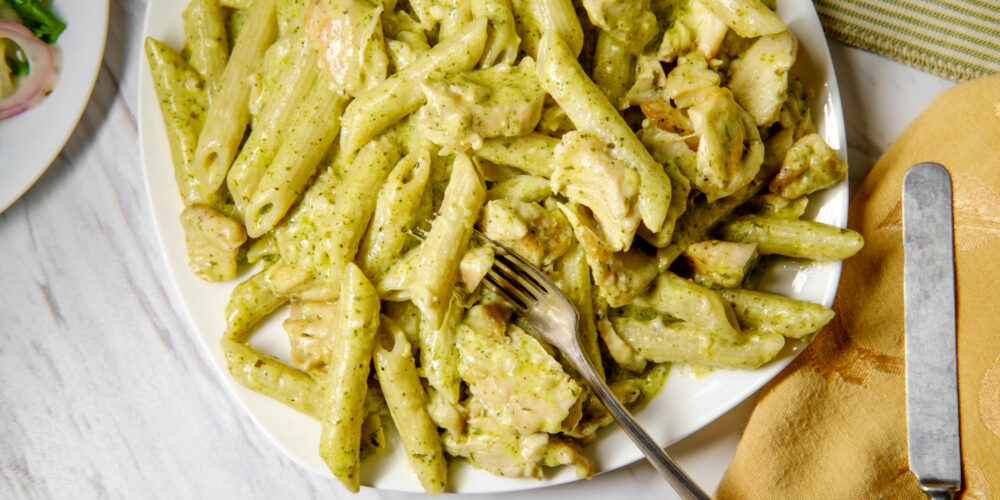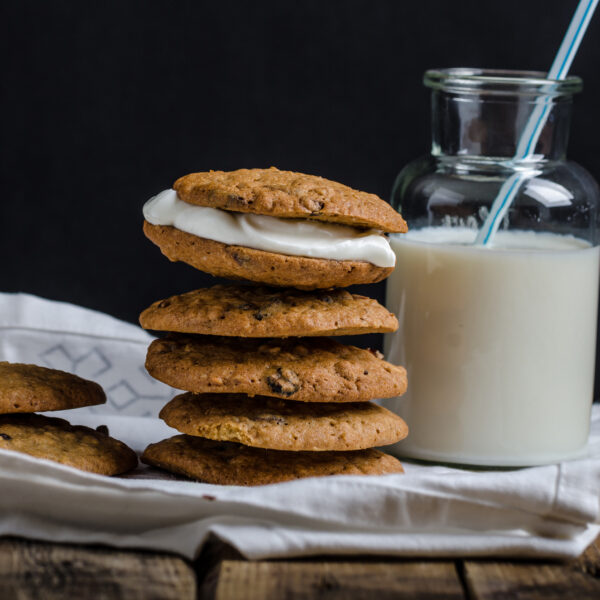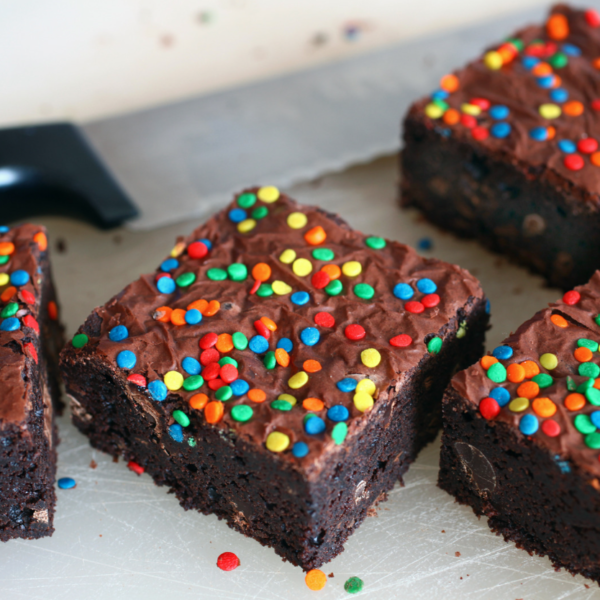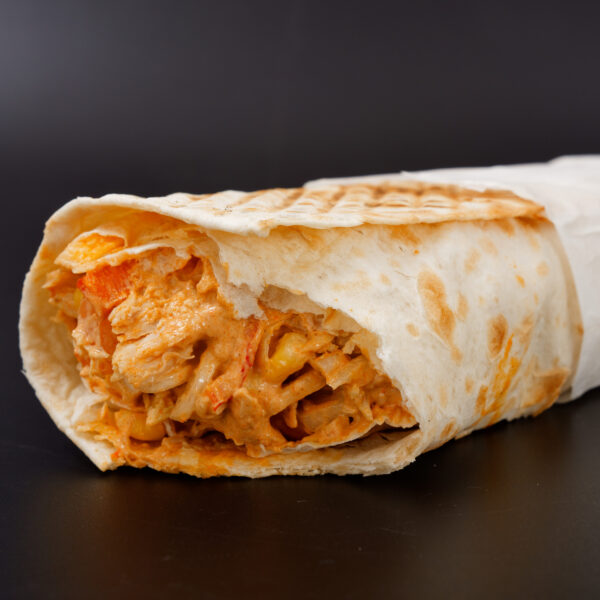Pasta is undoubtedly one of the most beloved comfort foods worldwide. Whenever I need comfort food, I look to pasta. Its versatility, affordability, and ease of preparation makes it a go-to choice for busy weeknight dinners and special occasions alike. For those looking to maintain or increase their protein intake, pasta dishes may seem like an unlikely option. BUT, in this blog post, I’ll share a protein-packed pasta recipe with chicken and explore a few creative and delicious ways to fit more protein into your pasta dishes. This proves that pasta can be enjoyed regularly, while still helping meet dietary goals.
Before jumping to the recipe, here are three things to keep in mind when prioritizing protein intake.
3 Easy Ways to Amp Up the Protein in Your Pasta Dinner
Pasta dinners are not off-limits for those looking to increase their protein intake while still maintaining their wellness goals. With these tips for boosting protein in your pasta dishes, help cultivate comforting and satisfying flavors of pasta while meeting your dietary goals. Whether you choose protein-packed pasta, incorporate lean proteins, load up on veggies, or get creative with sauces, there are countless ways to make your pasta dinners both delicious and nutritious.
Incorporate Lean Protein Sources
One of the simplest ways to add protein to your pasta dinner is by incorporating lean protein sources. Grilled chicken breast, turkey, lean beef, or even plant-based alternatives like tofu or tempeh are excellent choices. Simply slice or dice the protein source of your choice and toss it into your pasta dish for a hearty and protein-packed meal.
Choose the Pasta
The foundation of any great pasta dish is, of course, the pasta itself. Nowadays, you can find a variety of high-protein pasta options made from different ingredients. Some popular choices include chickpea pasta, lentil pasta, black bean pasta, and edamame pasta. These alternatives are not only rich in protein but also, many are gluten-free.
Create a Protein-Packed Sauce
The sauce is where you can get creative with protein additions. In this pesto pasta recipe with chicken, I added cottage cheese for a few added grams of protein. Another way to add protein to the sauce is by blending silken tofu, hemp seeds, or cashews, with herbs and spices to create a flavorful, dairy-free high-protein sauce. When adding Greek yogurt, cottage cheese, or tofu, always blend with other sauce ingredients to get a balanced flavor and creamy consistency. Similarly with the plant-based option.
Toasted pine nuts, slivered almonds, or chopped walnuts are also a great garnish for your pasta for an added crunch and a protein boost. Try experimenting with different ingredients to discover a sauce that both tastes great and provides a boost of protein.
BONUS: don’t forget to embrace the cheese
Cheese lovers, take note! Cheese can be a delicious source of protein for your pasta dishes. Choose grated Parmesan, Pecorino Romano, or ricotta cheese to sprinkle over your pasta. These cheeses not only enhance the flavor but also contribute protein to your meal. Remember to use them in moderation if you are tracking calories but overall listen to what your body needs.
Let’s get Into the Recipe
Preparation Time: 30 minutes
Cooking Time: 20 minutes
Servings: 4 (or two and yields lunch leftover for the following day)
Ingredients:
For the Pesto Sauce:
- 2 cups fresh basil leaves, packed
- 1/2 cup grated Parmesan cheese
- 1/2 cup pine nuts, toasted
- 2 cloves garlic, minced
- 1/2 cup extra-virgin olive oil
- Salt and pepper to taste
- Juice of 1 lemon
- 1 Cup Cottage cheese
For the Pasta:
- 12 ounces pasta of choice
- 2 boneless, skinless chicken breasts
- 1 tablespoon olive oil
- Salt and pepper to taste
Optional:
- Cherry tomatoes
- Fresh basil leaves
- Grated Parmesan cheese
Instructions:
- In a food processor or high-speed blender, combine the basil leaves, grated Parmesan cheese, toasted pine nuts, and minced garlic.
- Pulse the mixture until it becomes a coarse paste.
- With the food processor running, slowly drizzle in the extra-virgin olive oil until the pesto is smooth and well combined.
- Add cottage cheese, salt, pepper, and lemon juice to taste. Adjust the seasoning as needed.
- Cook the pasta and then drain and set aside. You can drizzle a little olive oil over it to prevent sticking.
- Season the chicken breasts with salt and pepper and cook in a large skillet over medium-high heat and cook for about 6-8 minutes per side or until they are cooked through and have a golden-brown crust.
- Remove the chicken from the skillet and let it rest for a few minutes. Then, slice it into thin strips or bite-sized pieces.
- Combine the pasta, pesto, and chick in a large mixing bowl, and combine the cooked pasta, pesto sauce, and sliced chicken. Toss everything together until the pasta and chicken are well coated with the pesto sauce.
- Serve. If desired, garnish with halved cherry tomatoes, nuts, fresh basil leaves, and grated Parmesan cheese.
NOTES
– If you are running short on time, a canned pesto sauce is a great option (this is what I normally opt for). Just blend the jar of pesto with 1 cup of cottage cheese, prepare chicken, and boil pasta.
– If you are looking for a low-carb option, I like to use hearts of palm pasta. The brand Palmini is yummy and they have bulk buying options on Amazon.
– Customize this recipe by adding some steamed vegetables like broccoli or spinach for extra nutrition and serving of green veggies.
– Adjust the consistency of the pesto by adding more olive oil if needed.
Conclusion
In conclusion, this healthy pasta pesto with chicken recipe proves that you don’t have to sacrifice flavor for wellness. With the vibrant green pesto made from fresh basil, toasted pine nuts, and a touch of Parmesan cheese, this dish is a celebration of wholesome ingredients. The addition of lean chicken breast and creamy cottage cheese to the sauce adds protein and substance to keep you satisfied.
Whether you’re cooking for yourself, your family, or hosting guests, this healthy pesto pasta with chicken is sure to impress. Its vibrant colors and fresh flavors will make it a go-to recipe. Plus, you can always create variations with your favorite vegetables or whole grains to suit your current preferences. Comment when you try it!
xxx
Allie M.





Leave a Reply